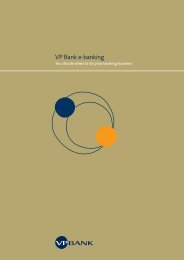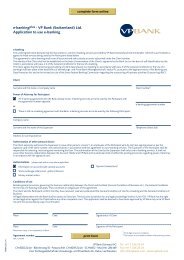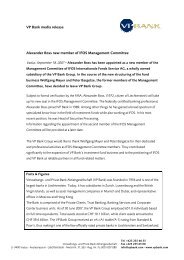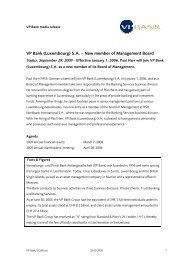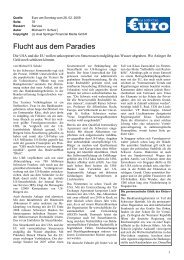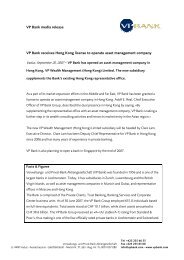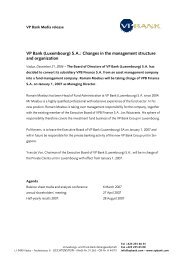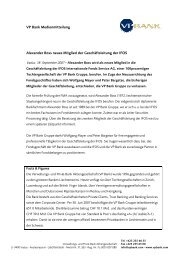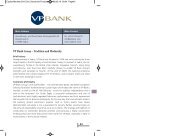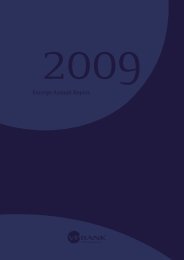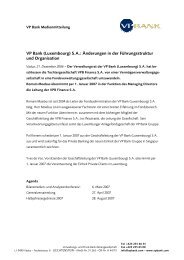Der Diamant – einmalig und zeitlos The Diamond – Unique and ...
Der Diamant – einmalig und zeitlos The Diamond – Unique and ...
Der Diamant – einmalig und zeitlos The Diamond – Unique and ...
Sie wollen auch ein ePaper? Erhöhen Sie die Reichweite Ihrer Titel.
YUMPU macht aus Druck-PDFs automatisch weboptimierte ePaper, die Google liebt.
<strong>The</strong> <strong>Diamond</strong> <strong>–</strong><br />
<strong>Unique</strong> <strong>and</strong> Timeless<br />
Hardly any other precious stone exerts a greater fascination with<br />
its brilliance, hardness <strong>and</strong> elegance than the diamond. But is it<br />
also a good investment <strong>–</strong> especially in times of crisis <strong>–</strong> which can<br />
safeguard against inflation <strong>and</strong> still yield an attractive return?<br />
On August 22, 2006, the “Lesotho Promise” saw the light of day. It was<br />
dug out of the Letseng diamond mine in the kingdom of Lesotho. At a<br />
weight of 603 carats (121 grams), it is the largest diamond fo<strong>und</strong> since the<br />
beginning of the twentieth century. Classified in the highest, i.e. the least<br />
impure, color category “D”, the raw diamond alone fetched a price of 12.4<br />
million US dollars at an auction in Antwerp.<br />
In July 2007, the buyer, the South African <strong>Diamond</strong> Corporation<br />
(SAFDICO), presented the public with the results of their work: a remarkable<br />
26 stones were cut from the raw diamond, the largest a pear shape<br />
with a weight of 75 carats, the smallest a 0.55-carat ro<strong>und</strong> brilliant. <strong>The</strong><br />
cut stones together weigh 224 carats <strong>and</strong>, according to SAFDICO, would<br />
fetch over 20 million US dollars. An increase in value of over 60 percent in<br />
roughly one year so<strong>und</strong>s like an asset investment that every investor would<br />
like to call his own <strong>–</strong> <strong>and</strong> not only in times of the subprime crisis <strong>and</strong> a<br />
turbulent shares market.<br />
WEALTH<br />
146<br />
<strong>Der</strong> <strong>Diamant</strong> <strong>–</strong><br />
<strong>einmalig</strong> <strong>und</strong> <strong>zeitlos</strong><br />
Kaum ein <strong>and</strong>erer Edelstein übt durch seine Leuchtkraft, Härte <strong>und</strong><br />
Eleganz eine grössere Faszination auf den Menschen aus als der<br />
<strong>Diamant</strong>. Ist er aber auch eine interessante Investmentanlage <strong>–</strong><br />
vor allem in Krisenzeiten <strong>–</strong> die gegen Inflation schützt <strong>und</strong> zudem<br />
noch eine attraktive Rendite abwirft?<br />
Am 22. August 2006 erblickte der «Lesotho Promise» das Licht der Welt.<br />
Ausgegraben wurde er in der Letseng <strong>Diamant</strong>enmine im Königreich Lesotho.<br />
Mit einem Gewicht von 603 Karat (121 Gramm) ist er der grösste<br />
gef<strong>und</strong>ene <strong>Diamant</strong> seit Anfang des 20. Jahrh<strong>und</strong>erts. Durch die Einstufung<br />
in die höchste, sprich die am wenigsten verunreinigte Farbkategorie «D»,<br />
erzielte bereits der Rohdiamant bei einer Auktion in Antwerpen einen Preis<br />
von 12.4 Millionen US-Dollar.<br />
Im Juli 2007 konnte sein Käufer, die South African <strong>Diamond</strong> Corporation<br />
(SAFDICO), der Öffentlichkeit die Produkte aus der Weiterverarbeitung<br />
präsentieren: Beachtliche 26 Steine wurden aus dem Rohdiamanten gewonnen<br />
<strong>–</strong> der grösste mit einem Gewicht von 75 Karat in Pear-Form, der kleinste<br />
ein r<strong>und</strong>er Brillant von 0.55 Karat. Die fertigen Steine erreichen zusammen<br />
ein Gewicht von 224 Karat <strong>und</strong> werden gemäss SAFDICO über 20 Millionen<br />
US-Dollar einbringen. Eine Wertsteigerung von mehr als 60 Prozent<br />
in r<strong>und</strong> einem Jahr klingt nach einer Vermögensanlage, welche wohl jeder<br />
Anleger gerne sein Eigen nennen würde <strong>–</strong> <strong>und</strong> dies nicht nur in Zeiten von<br />
Subprimekrise <strong>und</strong> Aktienmarktturbulenzen.<br />
Are diamonds the gold of the future?<br />
Since precious metals have partly experienced a massive value increase in<br />
recent years, with the share prices of numerous supporting <strong>and</strong> processing<br />
businesses also able to profit, it seems obvious to project a similar fantasy<br />
onto diamonds. Investment experts, who tout precious stones as the investment<br />
of the coming years, claim that production is now decreasing for the<br />
first time in 25 years. It is thus expected that by 2015, two percent fewer<br />
diamonds will be produced than today. <strong>The</strong> reason for this lies on the one<br />
h<strong>and</strong> in their decreasing availability, as is the case with most raw materials,<br />
<strong>and</strong> on the other h<strong>and</strong> in the increasing worldwide dem<strong>and</strong>, especially in<br />
China <strong>and</strong> India.<br />
Whoever is looking for rapid price increases, however, may be disappointed.<br />
<strong>Diamond</strong> prices are indeed not prone to market-value slides like other raw<br />
materials or shares, but the diamond market does have several features that<br />
make it unsuitable for private investors because the prices are not set by the<br />
free play of supply <strong>and</strong> dem<strong>and</strong>. Transparency for all market participants,<br />
which is one of the f<strong>und</strong>amental prerequisites for a functional market, does<br />
not exist in the world of the diamond trade. Until 2001, the worldwide<br />
diamond market was controlled by the Central Selling Organisation (CSO),<br />
a cartel fo<strong>und</strong>ed by the British-South African diamond company De Beers<br />
Consolidated Mines. For over 70 years, it made sure that De Beers controlled<br />
aro<strong>und</strong> 90 percent of the worldwide market <strong>and</strong> that even the former Soviet<br />
Union delivered the full output of its diamond mines to De Beers.<br />
WEALTH<br />
147<br />
Sind <strong>Diamant</strong>en das Gold der Zukunft?<br />
Nachdem die Edelmetalle in den vergangenen Jahren teilweise massiv an<br />
Wert zulegen <strong>und</strong> auch die Aktienkurse vieler Förder- <strong>und</strong> Verarbeitungsunternehmen<br />
davon profitieren konnten, liegt es nahe, eine ähnliche Phantasie<br />
auf <strong>Diamant</strong>en zu projizieren. Anlageexperten, welche die edlen Steine als<br />
das Investment der kommenden Jahre anpreisen, argumentieren, dass nach<br />
25 Jahren nun erstmals die Produktion zurückgehe. So wird erwartet, dass<br />
bis 2015 weltweit zwei Prozent weniger <strong>Diamant</strong>en gefördert werden als<br />
heute. <strong>Der</strong> Gr<strong>und</strong> liegt einerseits, wie bei den meisten Rohstoffen, in seiner<br />
abnehmenden Verfügbarkeit <strong>und</strong> <strong>and</strong>ererseits in der steigenden weltweiten<br />
Nachfrage, allen voran aus China <strong>und</strong> Indien.<br />
Wer jedoch auf rasch steigende Preise setzt, dürfte enttäuscht werden. Die<br />
<strong>Diamant</strong>enpreise kennen zwar keine Kursrutsche wie <strong>and</strong>ere Rohstoffe oder<br />
Aktien, jedoch weist der <strong>Diamant</strong>enmarkt einige Eigenheiten auf, der ihn<br />
für Privatanleger ungeeignet macht. Denn die Preise richten sich nicht nach<br />
dem freien Spiel von Angebot <strong>und</strong> Nachfrage. Transparenz für alle Marktteilnehmer,<br />
als eine der gr<strong>und</strong>legenden Voraussetzungen für einen funktionierenden<br />
Markt, gibt es in der Welt des <strong>Diamant</strong>enh<strong>and</strong>els nicht. Bis 2001<br />
beherrschte das vom britisch-südafrikanischen <strong>Diamant</strong>enkonzern De Beers<br />
Consolidated Mines gegründete Kartell Central Selling Organisation (CSO)<br />
den weltweiten <strong>Diamant</strong>enmarkt. Über 70 Jahre lang sorgte es dafür, dass<br />
De Beers r<strong>und</strong> 90 Prozent des weltweiten Markts kontrollierte <strong>und</strong> sogar<br />
die damalige Sowjetunion den Ertrag ihrer <strong>Diamant</strong>enminen vollständig<br />
bei De Beers ablieferte.
Market control as guarantor of success<br />
<strong>The</strong> CSO bought up all the raw diamonds worldwide <strong>and</strong> put as many of<br />
them back on the market as was required. An oversupply, according to their<br />
thinking, would push down prices, while an overly low supply would result<br />
in lost earnings. De Beers thus operated as middle-man <strong>and</strong> buffer between<br />
fluctuating market dem<strong>and</strong> <strong>and</strong> mining countries, <strong>and</strong> prevented large price<br />
jumps in one or the other direction. After the end of the cartel, the De<br />
Beers subsidiary <strong>Diamond</strong> Trading Company (DTC) has taken over sales<br />
<strong>and</strong> distribution of all the stones produced in the De Beers mines, which<br />
amounts to aro<strong>und</strong> 40 percent of world production. <strong>The</strong> buying process<br />
continues to run according to the pattern of the CSO days: ten times a year,<br />
“sightholders” meet in DTC headquarters in London. This currently involves<br />
93 polishers <strong>and</strong> traders, who fulfill the DTC’s economic, social <strong>and</strong> ethical<br />
criteria for being their “suppliers of<br />
choice”. <strong>The</strong> status of sightholder is<br />
held only for a limited time; the next<br />
review comes up in 2011.<br />
To buy diamonds, each sightholder is<br />
led individually into a room where he<br />
is given the stones, pre-selected by De<br />
Beers, to inspect in a plain cardboard<br />
box. <strong>The</strong> sightholders have no influence<br />
over which raw stones they are<br />
given, since the mix of color, size <strong>and</strong> quality in the box is determined by<br />
DTC alone based on market analyses. <strong>The</strong> sightholders can find fault with<br />
the purity or color of a stone but they can only bargain about the price when<br />
it comes to stones of exceptional quality. One box is on average worth about<br />
500,000 US dollars. Individual sightholders acquire diamonds, per sighting,<br />
in value of up to several million US dollars, which must be paid for in cash<br />
within two weeks. In 2007, DTC earned aro<strong>und</strong> 6.8 billion US dollars in<br />
this way <strong>and</strong> made a profit of 483 million US dollars.<br />
WEALTH<br />
148<br />
Marktkontrolle als Erfolgsgarant<br />
Die CSO kaufte weltweit alle Rohdiamanten auf <strong>und</strong> brachte davon so viele<br />
wieder auf den Markt, wie gefragt waren. Ein Überangebot, so der Gedanke,<br />
drücke die Preise, während ein zu tiefes Angebot Einkommenseinbussen<br />
zur Folge hätte. De Beers wirkte so als Mittler <strong>und</strong> Puffer zwischen der<br />
schwankenden Marktnachfrage <strong>und</strong> den Förderländern <strong>und</strong> verhinderte<br />
grössere Preissprünge in die eine oder die <strong>and</strong>ere Richtung. Seit dem Ende<br />
des Kartells hat die De Beers-Tochter <strong>Diamond</strong> Trading Company (DTC)<br />
den Vertrieb aller in den De Beers-Minen geförderten Steine, immerhin r<strong>und</strong><br />
40 Prozent der Weltproduktion, übernommen. <strong>Der</strong> Kaufprozess vollzieht<br />
sich weiterhin nach dem Muster aus CSO-Tagen: Zehnmal im Jahr treffen<br />
sich im Hauptsitz der DTC in London die so genannten «Sightholder».<br />
Dabei h<strong>and</strong>elt es sich aktuell um 93 ausgewählte Schleifer <strong>und</strong> Händler,<br />
welche die wirtschaftlichen, sozialen<br />
<strong>und</strong> ethischen Kriterien der DTC<br />
an ihre «Supplier of choice» erfüllen.<br />
Ihren Status als Sightholder erhalten<br />
sie zeitlich befristet; 2011 steht die<br />
nächste Überprüfung an.<br />
Beim <strong>Diamant</strong>enkauf wird jeder<br />
Sightholder einzeln in einen Raum<br />
geführt, wo er die Steine, welche De<br />
Beers zuvor ausgewählt hat, in einer<br />
schlichten Kartonschachtel zur Sichtnahme<br />
gereicht bekommt. Einfluss auf<br />
die Rohware, die sie bekommen, haben die Sightholder nicht, denn die<br />
Mischung von Farben, Grössen <strong>und</strong> Qualität in der Schachtel bestimmt<br />
allein die DTC auf der Basis von Marktanalysen. Die Sightholder können<br />
zwar die Reinheit oder Farbe eines Steins beanst<strong>and</strong>en, über den Preis verh<strong>and</strong>elt<br />
wird jedoch nur bei Steinen von aussergewöhnlicher Qualität. Eine<br />
Schachtel hat durchschnittlich einen Wert von r<strong>und</strong> 500`000 US-Dollar.<br />
Pro Sichtung erwerben einzelne Sightholder <strong>Diamant</strong>en im Wert von bis zu<br />
mehreren Millionen US-Dollar, wobei innerhalb von zwei Wochen in bar<br />
bezahlt werden muss. 2007 erlöste DTC auf diese Weise r<strong>und</strong> 6.8 Milliarden<br />
US-Dollar <strong>und</strong> erzielte einen Gewinn von 483 Millionen US-Dollar.<br />
Dealings on the basis of trust<br />
An essential factor in the functioning of the diamond market is the trust the<br />
agents have amongst each other. This is evidenced strikingly in the diamond<br />
trade in Midtown Manhattan, where even today the valuable stones pass<br />
“uncontrolled” from h<strong>and</strong> to h<strong>and</strong>; the trust amongst the group of Orthodox<br />
Jewish traders does not require any techniques of control. Every deception<br />
is sanctioned on the spot, which is a risk that no agent will take.<br />
Obviously, the diamond trade has little in common with a transparent,<br />
efficient market. Markets are efficient above all because of public access to<br />
information that is then used by the market participants in the process of<br />
establishing prices. In this sense, a free market f<strong>und</strong>amentally survives on<br />
free access for all agents as well as transparent rules regarding the business<br />
in question.<br />
<strong>The</strong> shortfalls of the diamond trade are clear <strong>and</strong> yet, up until now, a transparent<br />
market, as for example with gold, has not been able to be established.<br />
This is not, however, for a lack of attempts. As a consequence of De Beers’<br />
loss of power, diamond traders met with representatives of banks <strong>and</strong> stock<br />
exchanges in June 2007 to discuss a plan for futures contracts on diamonds.<br />
In light of sharply rising dem<strong>and</strong> in India <strong>and</strong> China, producers as well<br />
as traders need to protect themselves against price fluctuations. <strong>The</strong> same<br />
goes for banks that finance diamond traders as well as for insurers. Futures<br />
contracts would make it possible for market participants to secure their<br />
production or their stocks against a loss of value.<br />
WEALTH<br />
149<br />
Geschäfte auf Vertrauensbasis<br />
Ein wesentlicher Faktor für das Funktionieren des <strong>Diamant</strong>enmarkts ist<br />
das Vertrauen der Akteure unterein<strong>and</strong>er. Dies wird eindrucksvoll im <strong>Diamant</strong>enh<strong>and</strong>el<br />
in Midtown-Manhattan dokumentiert, wo bis heute die<br />
wertvollen Steine «unkontrolliert» von H<strong>and</strong> zu H<strong>and</strong> gehen; das Vertrauen<br />
innerhalb der Gruppe orthodox-jüdischer Händler verlangt nach keiner<br />
technischen Kontrolle. Jegliche Täuschung würde auf der Stelle sanktioniert,<br />
diesem Risiko will sich kein Akteur aussetzen.<br />
<strong>Der</strong> <strong>Diamant</strong>enh<strong>and</strong>el hat offensichtlich mit einem transparenten, effizienten<br />
Markt nicht viel gemein. Effizient werden Märkte vor allem durch die<br />
öffentliche Verfügbarkeit von Informationen, welche dann von den Marktteilnehmern<br />
im Prozess der Preisbildung verarbeitet werden. Darüber hinaus<br />
lebt ein freier Markt gr<strong>und</strong>sätzlich vom freien Zugang für alle Akteure sowie<br />
transparenten Regeln hinsichtlich des stattfindenden H<strong>and</strong>els.<br />
Die Defizite des <strong>Diamant</strong>enh<strong>and</strong>els liegen auf der H<strong>and</strong> <strong>und</strong> dennoch<br />
konnte sich ein transparenter Markt, wie zum Beispiel für Gold, bisher<br />
nicht etablieren. An Versuchen dazu fehlt es jedoch nicht. Im Zuge des<br />
Machtverlusts von De Beers diskutierten im Juni 2007 <strong>Diamant</strong>enhändler<br />
mit Vertretern von Banken <strong>und</strong> Börsen ein Konzept für Terminkontrakte<br />
auf <strong>Diamant</strong>en. Angesichts der rasant wachsenden Nachfrage aus Indien <strong>und</strong><br />
China haben sowohl Produzenten wie Händler das Bedürfnis, sich gegen<br />
Preisschwankungen abzusichern. Ähnliches gilt für Banken, die <strong>Diamant</strong>enh<strong>and</strong>el<br />
finanzieren, <strong>und</strong> Versicherungen. Terminkontrakte würden es den<br />
Marktteilnehmern ermöglichen, ihre Produktion oder ihre Lagerbestände<br />
gegen einen Wertverlust abzusichern.
Categorization as the greatest challenge<br />
<strong>The</strong> classification of diamonds is highly complex. Since there is no clear<br />
reference point regarding individual features of quality <strong>–</strong> in contrast, for<br />
instance, to the crude oil market <strong>and</strong> the grades negotiated there <strong>–</strong> every<br />
stone needs to be precisely inspected by one or more experts. <strong>The</strong> categorization<br />
of raw diamonds stretches across a broad b<strong>and</strong> of classes differentiated<br />
by size, form, quality <strong>and</strong> color. In addition, nearly all raw diamonds have<br />
”inclusions”, or entrapped materials. While this makes each stone unique,<br />
it also detracts from its value. <strong>The</strong> principle is the purer, the better.<br />
Once the raw stone has been bought, it is cut <strong>and</strong> polished, with the most<br />
popular cut being the ro<strong>und</strong> brilliant with its 57 facets. <strong>The</strong> polish brings out<br />
the spectral radiance <strong>and</strong> luminance of the stone; a well-polished diamond<br />
reflects light in <strong>and</strong> of itself.<br />
<strong>The</strong> value of the polished stone is determined by the “four Cs”. <strong>The</strong> cut,<br />
i.e. the polish, should bring out the full brilliance <strong>and</strong> fire of the stone. If<br />
the stone is cut too deep or too flat, this reduces its brilliance <strong>and</strong> hence its<br />
value. In addition, buyers look out for the symmetry of the cut. In regard to<br />
color, the stones without color are the most in dem<strong>and</strong>. In the event that all<br />
the other “C” criteria are equal in value, a diamond‘s value will increase in<br />
accordance with the rarity of its color. Size, type, position <strong>and</strong> luminance of<br />
the inclusions influence the clarity of the diamond <strong>and</strong> its price. <strong>The</strong> same<br />
holds for the weight (1 carat = 0.2 grams) as the final “C”.<br />
WEALTH<br />
150<br />
Kategorisierung als grösste Herausforderung<br />
Die Klassifizierung von <strong>Diamant</strong>en ist äusserst komplex. Da es keine eindeutige<br />
Referenz hinsichtlich der einzelnen Qualitätsmerkmale gibt, im<br />
Gegensatz beispielsweise zum Rohölmarkt <strong>und</strong> den dort geh<strong>and</strong>elten Sorten,<br />
bedarf jeder Stein stets der genauen Prüfung durch einen oder mehrere erfahrene<br />
Experten. Die Kategorisierung von Rohdiamanten erstreckt sich über<br />
eine weite B<strong>and</strong>breite verschiedener Klassen, die sich nach Grösse, Form,<br />
Qualität <strong>und</strong> Farbe richten. Hinzu kommt, dass beinahe jeder Rohdiamant<br />
so genannte Inklusionen, also Einlagerungen, aufweist. Diese machen den<br />
Stein zwar einzigartig, sind jedoch seiner Werthaltigkeit abträglich. Denn<br />
es gilt: Je reiner, desto besser.<br />
Ist der Rohstein einmal geh<strong>and</strong>elt, wird er geschliffen, wobei der populärste<br />
Schliff der r<strong>und</strong>e Brillant mit 57 Facetten ist. <strong>Der</strong> Schliff bringt den<br />
Spektralglanz des Steins <strong>und</strong> seine Helligkeit hervor; ein gut geschliffener<br />
<strong>Diamant</strong> reflektiert das Licht in sich selbst.<br />
Die Bewertung des geschliffenen Steins richtet sich nach den vier «C’s»:<br />
<strong>Der</strong> Cut, also der Schliff, soll den Glanz <strong>und</strong> das Feuer des Steins zur vollen<br />
Entfaltung bringen. Ist der Stein zu tief oder zu flach geschliffen, verringert<br />
dies seinen Glanz <strong>und</strong> entsprechend seinen Wert. Darüber hinaus achten<br />
Käufer darauf, dass der Schliff symmetrisch ist. Bezüglich Farbe (color)<br />
sind farblose Steine am gefragtesten. Im gesetzten Fall, dass die übrigen<br />
«C-Kriterien» gleichwertig sind, werden <strong>Diamant</strong>en jedoch umso wertvoller,<br />
je seltener ihre Farbe ist. Grösse, Art, Position <strong>und</strong> Helligkeit der Inklusionen<br />
beeinflussen die Klarheit (clarity) des <strong>Diamant</strong>en <strong>und</strong> haben Einfluss<br />
auf seinen Preis. Gleiches gilt für das Gewicht (1 Karat = 0.2 Gramm) als<br />
letztes «C».<br />
With the exception of the weight, the criteria leave a lot of room for subjective<br />
appraisals <strong>and</strong> interpretations, particularly if one is not a pronounced<br />
expert with many years’ experience. This subjectivity is one of the main<br />
reasons why it has not yet been possible to establish a functional public<br />
market. Certified value appraisals of diamonds can be made by a diamond<br />
inspection laboratory, but not every certificate is worth the same. <strong>The</strong>re are<br />
only three institutions worldwide which are above suspicion: the Hoge Raad<br />
voor <strong>Diamant</strong> (HRD) in Antwerp, the Gemological Institute of America<br />
(GIA) in Carlsbad, California, <strong>and</strong> the German <strong>Diamond</strong> <strong>and</strong> Gemstone<br />
Laboratories (DEL) in Idar-Oberstein.<br />
However, it is not just these rather technical problems that st<strong>and</strong> in the way<br />
of a functional public diamond market. It is precisely the deals behind closed<br />
doors <strong>and</strong> the declared expert knowledge required by the business that add<br />
to the mystical character of diamonds <strong>and</strong> ultimately keep the value stable.<br />
Nothing would be worse for the image of the diamond than if it were to<br />
degenerate into a simple stone traded according to the usual procedures<br />
anonymously <strong>and</strong> en masse on the raw materials exchange.<br />
Verwaltungs- <strong>und</strong> Privat-Bank Aktiengesellschaft (VP Bank) was fo<strong>und</strong>ed in 1956 <strong>and</strong> is one<br />
of the largest banks in Liechtenstein. Today, it has subsidiaries in Zurich, Luxembourg, the<br />
British Virgin Isl<strong>and</strong>s <strong>and</strong> Singapore, as well as asset management companies in Munich,<br />
Dubai <strong>and</strong> Hong Kong, <strong>and</strong> representative offices in Moscow <strong>and</strong> Hong Kong. <strong>The</strong> Bank is<br />
comprised of the “Private Banking Clients” <strong>and</strong> “Intermediaries” business units, the “Banking<br />
Services” service unit, as well as the “Corporate Center”. As at June 30, 2008, VP Bank<br />
Group employed 718.1 individuals based on full-time equivalents. Total assets stood at<br />
CHF 11.5 billion, while client assets amounted to CHF 39.9 billion. <strong>The</strong> VP Bank Group<br />
has received an «A» (A/ stable/A-1) rating from St<strong>and</strong>ard& Poor’s, thus making it one of<br />
the few officially rated private banks in Liechtenstein <strong>and</strong> Switzerl<strong>and</strong>.<br />
WEALTH<br />
151<br />
Abgesehen vom Gewicht lassen diese Kriterien einen grossen Spielraum<br />
für subjektive Einschätzungen <strong>und</strong> Interpretationen zu, vor allem wenn<br />
man kein ausgewiesener Experte mit langjähriger Erfahrung ist. Die Subjektivität<br />
ist einer der Hauptgründe, weshalb es bis heute nicht gelungen<br />
ist, einen funktionierenden öffentlichen Markt zu etablieren. Definitive<br />
Wertschätzungen eines <strong>Diamant</strong>en mit Zertifikat werden von einem <strong>Diamant</strong>enprüflabor<br />
zwar erstellt, doch nicht jedes Zertifikat ist gleichwertig.<br />
Über jeden Zweifel erhaben sind weltweit nur drei Institute: der Hoge Raad<br />
voor <strong>Diamant</strong> (HRD) in Antwerpen, das Gemological Institute of America<br />
(GIA) in Carlsbad, Kalifornien, <strong>und</strong> die Deutschen <strong>Diamant</strong>- <strong>und</strong> Edelsteinlaboratorien<br />
(DEL) in Idar-Oberstein.<br />
Einem funktionierenden, öffentlichen <strong>Diamant</strong>enmarkt stehen jedoch nicht<br />
nur diese eher technischen Probleme entgegen. Gerade der H<strong>and</strong>el hinter<br />
verschlossenen Türen <strong>und</strong> das ausgesprochene Expertenwissen, das der H<strong>and</strong>el<br />
erfordert, tragen das ihrige zum mystischen Charakter von <strong>Diamant</strong>en bei<br />
<strong>und</strong> halten letztlich auch seinen Wert stabil. Nichts wäre schlimmer für das<br />
Image des <strong>Diamant</strong>en, als zu einem blossen Stein zu verkommen, der an einer<br />
h<strong>and</strong>elsüblichen Rohstoffbörse anonym <strong>und</strong> in Massen geh<strong>and</strong>elt wird.<br />
Die Verwaltungs- <strong>und</strong> Privat-Bank Aktiengesellschaft (VP Bank) wurde 1956 gegründet<br />
<strong>und</strong> gehört zu den grössten Banken Liechtensteins. Heute verfügt sie über Tochtergesellschaften<br />
in Zürich, Luxemburg, auf den British Virgin Isl<strong>and</strong>s <strong>und</strong> in Singapur, über Vermögensverwaltungsgesellschaften<br />
in München, Dubai <strong>und</strong> Hongkong sowie Repräsentanzen<br />
in Moskau <strong>und</strong> Hongkong. Die Bank besteht aus den Business Units «Private Banking<br />
Clients» <strong>und</strong> «Intermediaries», der Service Unit «Banking Services» sowie dem «Corporate<br />
Center». Per 30. Juni 2008 beschäftigte die VP Bank Gruppe teilzeitbereinigt 718.1<br />
Mitarbeitende. Die Bilanzsumme betrug CHF 11.5 Mrd. <strong>und</strong> das K<strong>und</strong>envermögen CHF<br />
39.9 Mrd. Die VP Bank Gruppe hat von St<strong>and</strong>ard & Poor’s das Rating «A» (A/ stable/A-1)<br />
erhalten. Damit ist sie eine der wenigen offiziell bewerteten Privatbanken in Liechtenstein<br />
<strong>und</strong> in der Schweiz.<br />
Verwaltungs- <strong>und</strong> Privat-Bank Aktiengesellschaft (VP Bank) . Aeulestrasse 6 . LI-9490 Vaduz<br />
Liechtenstein . Michael Hillbrink . Investment Consultant . Telefon +423 235 63 48<br />
www.vpbank.com oder Mail: michael.hillbrink@vpbank.com



